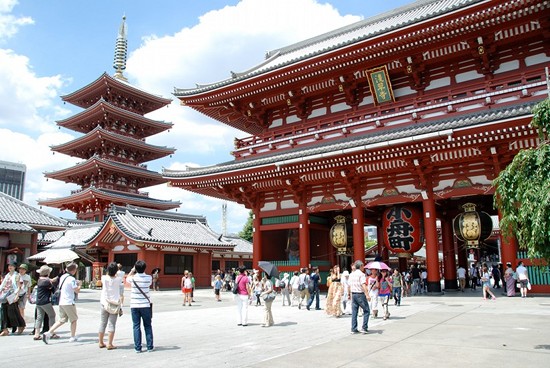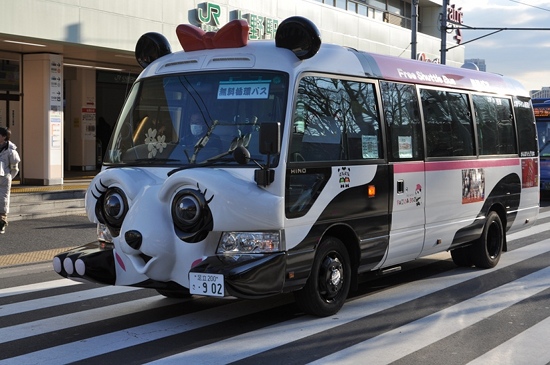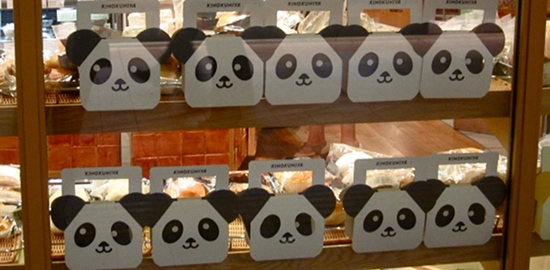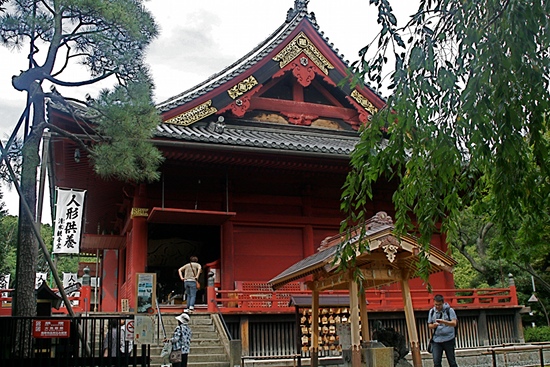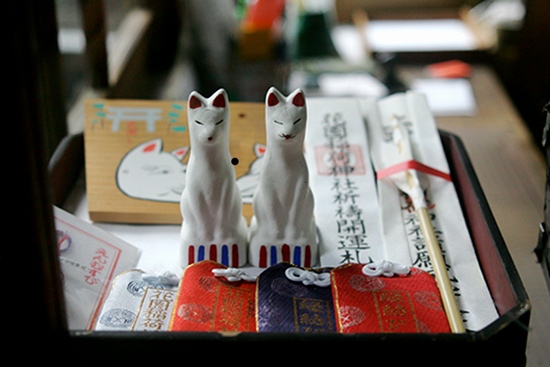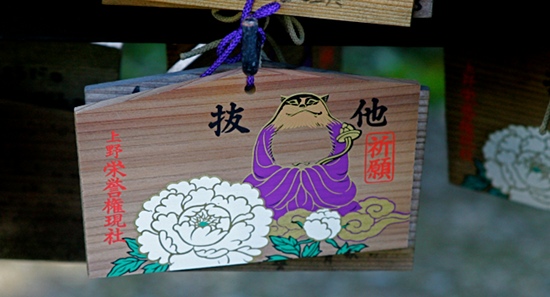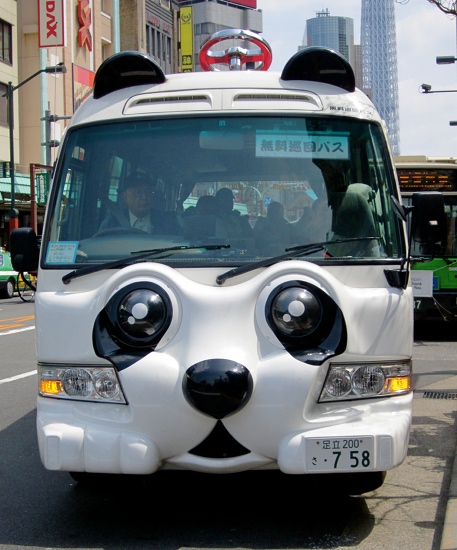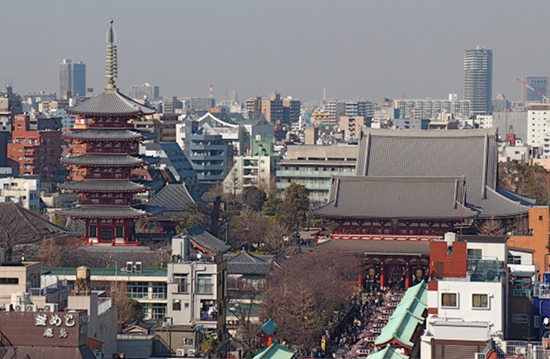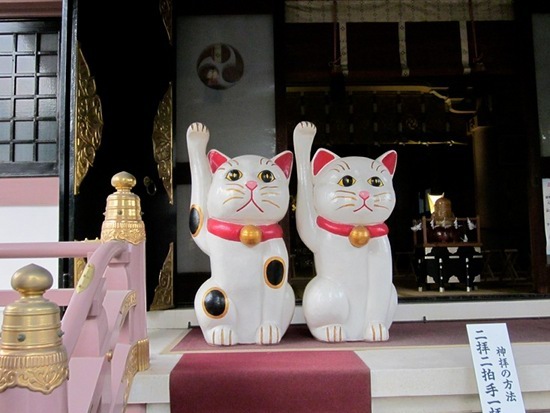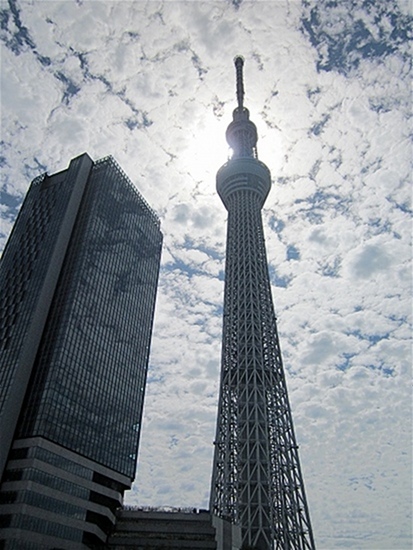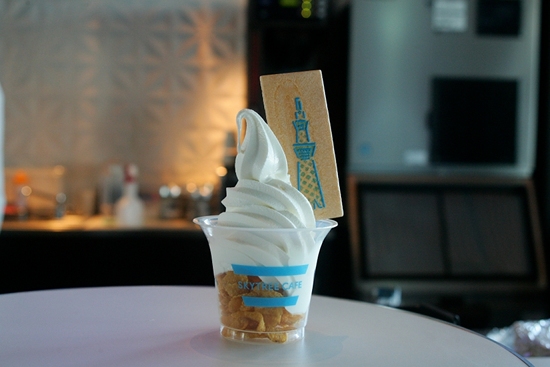Stunning Asakusa Sensoji Temple. Courtesy S. Nakada
A weaker yen means stronger travel incentives for visitors to Japan. Save even more with the Panda Bus. These fanciful hop-on/hop-off buses are a great way to tour Asakusa from Sensoji to Sky Tree or take in the world-famous cherry blossoms and museum row around Ueno Park. Best of all, both buses are free!
Ueno Panda Bus.
You'd think a bus with a giant black and white panda head on the front and wearing a pink bow would be pretty hard to ignore. But, somehow, the Panda Buses are one of Tokyo's best-kept tourist secrets. These shuttles zip along two circle-routes through the colorful Asakusa and Ueno areas every hour. Both routes run daily from 10 a.m to 5 p.m., except when the driver takes his lunch break at 1 p.m. Announcements are only in Japanese. Neither can accommodate wheelchairs.
Ueno: Beyond the fluffy pink cherry blossoms, Ueno Park hides a legacy of bloody battles, historic shrines and tales of crafty, supernatural animals. It's also home to Tokyo's only pair of real pandas at Ueno Zoo.
There is no escaping pandamania in this part of town. Before you even board the Panda Bus, you'll have to walk by shops selling panda cookies, panda cakes, panda pudding, panda toys, panda T-shirts, panda candy and panda crackers. And that's just inside the station.
For all your crunchy panda needs: panda crackers at Kinokuniya Market
Nearly everything you want to see in Ueno is packed into this historic park. The Ueno Panda Bus covers the entire park, a maze of nearby shopping streets, finally ending up in Asakusa and walking distance to stunning Sensoji temple. Get on at the JR Ueno Station 'Park' exit, directly across the street by the cross walk.
It's hard to think of Ueno as a battleground full of sword-wielding samurai. But on July 4, 1868, that's exactly what it was. After three hundred years at the top of the heap, the Tokugawa Shogunate made a last-ditch fight here against the forces of the Meiji restoration, drenching the area in blood and fire. What didn't burn was smashed to splinters by modern canon brought in by the reformers.
Ueno Kannondo was one of the few temples to survive the battle of 1868. Kannon is the Goddess of Mercy. Even soldiers didn't want to make her mad.
The triumphant Meiji Emperor decided to build Japan's first Western-style park on the war-torn site envisioning museums and broad public areas that would also incorporate the many shrines and temples -- whether they liked it or not.
The first few stops on the Panda Bus stay within the museum district, giving visitors a feel for the size and structure of this rambling place. For anyone interested in samurai swords and armor or ancient Japanese art, the Tokyo National Museum is a great stop.
From museum row, the bus heads towards the park's back entrance near Shinobazu Pond. Those wild and crazy Meiji reformers used to hold horse races around the shore. Now it's just kids and families racing swan boats on the water.
Get off here to explore the cluster of temples and shrines. Nearby is Hanazono Jinja with its bright pathway of red torii gates. This Shinto shrine is dedicated to Inari, the God of Rice, and guarded by his heavenly messengers, the foxes.
Take home some foxy magic of your own at Hanazono
To the right of the shrine, a cavern (O-Anasama) was excavated by the priests centuries ago as a spare den to placate the resident - and mischievous - fox spirits displaced during the building of the shrine.
Be sure to check out Ueno Toshogu where super-shogun Tokugawa Ieyasu is enshrined. His symbol is that smug looking Tanuki raccoon dog on the temple's ema votive tablet.
Super shogun Tokugawa Ieyasu was called 'Tanuki '-- though never to his face!
The man was just as tricky and clever as this supernatural, shapeshifting beast of legend. He not only ruled Japan but managed to have himself enshrined as a deity for all eternity. Now that's crafty.
From the temples it's an easy walk back to the station, the zoo for a peek at the real pandas, or just to take a break at one of two new coffee houses right by the main promenade.
The rest of the Panda Bus route twists and turns through a working class shopping and entertainment district, Okachimachi, that's fun to explore. It stops again at Ueno Station (the main entrance), then proceeds to Asakusa and the ROX building. If you want, cross the street and pick up the Asakusa Panda Bus here or stay on and return to Ueno Station.
Access: Ueno JR Station, Park Exit. If you're hungry, stop by the E-Cute concourse next to JR platform nine. The 'E' stands for 'eat' I think, as there are a dozen food shops here, both eat-in and take-away.
Asakusa Panda Bus.
Asakusa: Your first stop in this historic district should be the Asakusa Tourist Office, across the street from Kaminarimon Gate. This is a great place for information on the entire area including bus and boat tours. The tourist office has a friendly, bi-lingual staff, public bathrooms (hurrah!), an ATM, currency exchange, and something only this building can give you -- a bird's eye view of the nakamise shopping street and Sensoji Temple from the eighth floor. This is an amazing photo-op.
Bird's-eye view of Sensoji from the Tourist Office.
The buzz of Tokyo's old downtown, shitamachi, is loud and bright and Asakusa is on everyone's list of top sightseeing spots: Sensoji Temple and the nakamise shops lining the route to the famous red lantern gate; endearingly old Hanayashiki Amusement Park; and the city's new star attraction, Sky Tree tower.
The Panda Bus stops directly in front of the Tourist Office. Take a seat and make the whole circle if you like. I would, however, suggest two stops on the way.
Imado Jinja, (eight stops on) is a little shrine with a big reputation as the place to pray for l-o-v-e. Their symbol is two lucky beckoning cats, maneki neko, the personification (felinification?) of the enshrined male and female Shinto gods.
Imado Jinja's famous lucky cats help you get lucky in love.
They represent constancy in love and draw believers from all over the country. (The boy is the one on the left, the girl, on the right.) After praying, buy one of Imado's famous double-cat charms to bring the love-luck home or a colorful ema wooden votive tablet.
The cats in this ema tablet are dressed in Doll's Day finery.
Imado is also home to one of the Seven Gods of Good Fortune: Fukurokuju, the God of Luck (particularly for your offspring and property) and Longevity. He's the shiny wooden statue to the right of the lucky cats.
Take the Panda Bus to towering Sky Tree. Courtesy Mike Nakada.
Back on the bus, get off at Sky Tree and the vast entertainment complex, Solamachi. Besides shopping and dining options for every budget, an aquarium and planetarium, you have a chance to ascend the tower. Evening is the best time so you can watch the lights come on around the city. Up at the top, have a sky-high snack at the cafe.
Treat yourself to a Sky Tree sundae, 350 meters above the ground.
Tickets to the first platform are 2500 yen ($26) for adults.
Access: Asakusa Station, Ginza Metro line. Exit 1.
Asakusa and Ueno are not the only tourist spots with free bus service. Odaiba, on the other side of Rainbow Bridge, is made for Instagram moments with amazing views of the city, including Tokyo Tower and Sky Tree. The Aqua City, Decks and DIver City malls are full of shopping and dining options.
Odaiba Decks shopping center is right on the waterfront.
The free Bay Shuttle comes about every twenty minutes and stops at all the major attractions on the island. Catch it on the ground floor of Aqua City outside the food court.
Access: Tokyo Teleport Station, Rinkai Line. Daiba Station, Yurikamome monorail.
